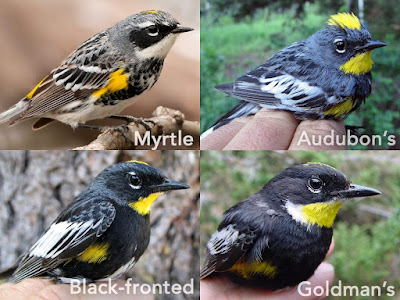 |
| The four forms of Yellow-rumped Warbler, Setophaga coronata, have distinct breeding ranges, with a narrow hybrid zone between Myrtle and Audubon's in western Canada. The researchers suggest that Myrtle, Audubon's and Goldman's are separate species. It's equivocal whether Black-fronted should be treated as a separate species or a subspecies of Audubon's.
Image by David Toews. AllAboutBirds.org
DOI: 10.1642/AUK-16-61.1
|
ABSTRACT
Populations that have experienced long periods of geographic isolation will diverge over time. The application of high-throughput sequencing technologies to study the genomes of related taxa now allows us to quantify, at a fine scale, the consequences of this divergence across the genome. Throughout a number of studies, a notable pattern has emerged. In many cases, estimates of differentiation across the genome are strongly heterogeneous; however, the evolutionary processes driving this striking pattern are still unclear. Here we quantified genomic variation across several groups within the Yellow-rumped Warbler species complex (Setophaga spp.), a group of North and Central American wood warblers. We showed that genomic variation is highly heterogeneous between some taxa and that these regions of high differentiation are relatively small compared to those in other study systems. We found that the clusters of highly differentiated markers between taxa occur in gene-rich regions of the genome and exhibit low within-population diversity. We suggest these patterns are consistent with selection, shaping genomic divergence in similar genomic regions across the different populations. Our study also confirms previous results relying on fewer genetic markers that several of the phenotypically distinct groups in the system are also genomically highly differentiated, likely to the point of full species status.
Keywords: evolutionary genomics, hybridization, gene flow, genotyping-by-sequencing, speciation, natural selection
 |
| The Myrtle form breeds in eastern and northern North America. The male's white throat distinguishes it from the three other forms, along with other differences.
Photo by Kelly Colgan Azar via Birdshare. flic.kr/p/bMAM4V
|
David P. L. Toews, Alan Brelsford, Christine Grossen, Borja Milá, and Darren E. Irwin. 2016. Genomic Variation Across the Yellow-rumped Warbler Species Complex [Variación genómica a través del complejo de especies de Setophaga coronata]. The Auk. 133(4); 698-717. DOI: 10.1642/AUK-16-61.1
'Butterbutt' warbler is likely three different species, DNA reveals http://phy.so/391335540 via @physorg_com
Goodbye, Yellow-Rump: Will We See A Return To Myrtle And Audubon’s Warblers?

RESUMEN: Las poblaciones que han experimentado largos periodos de aislamiento geográfico se diferenciarán con el paso del tiempo. La aplicación de tecnologías de secuenciación de alto rendimiento para el estudio de los genomas de taxones relacionados ahora nos permite cuantificar a escala fina las consecuencias de esta divergencia s través del genoma. Luego de numerosos estudios emerge un patrón notable: en muchos casos los estimados de diferenciación a través del genoma son fuertemente heterogéneos. Sin embargo, los procesos evolutivos que gobiernan este patrón aún no son claros. En este estudio cuantificamos la variación genómica a través de varios grupos dentro del complejo de especies de Setophaga coronata, un grupo de reinitas de Norte y Centroamérica. Mostramos que la variación genómica es altamente heterogénea entre algunos de los taxones y que las regiones de alta diferenciación son relativamente pequeñas en comparación con otros sistemas de estudio. Encontramos que las agrupaciones de marcadores áltamente diferenciados entre taxones se encuentran en regiones del genoma ricas en genes y también muestran baja diversidad intrapoblacional. Sugerimos que estos patrones son consistentes con un efecto de procesos de selección natural sobre la divergencia genómica en regiones genómicas similares a través de las diferentes poblaciones. Nuestro estudio también confirma resultados previos basados en pocos marcadores genéticos en los que se determinó que muchos de los grupos fenotípicamente distintos en este sistema también están áltamente diferenciados en sus genomas, probablemente al punto en que pueden ser consideradas con el estatus de especie.
Palabras clave: especiación, flujo genético, genómica evolutiva, genotipado por secuenciación, hibridación, selección natural
D. P. L. Toews, A. Brelsford and D. E. Irwin. 2014. Isotopic variation across the Audubon's–Myrtle warbler hybrid zone. Journal of Evolutionary Biology. 27(6); 1179-1191. DOI: 10.1111/jeb.12392


